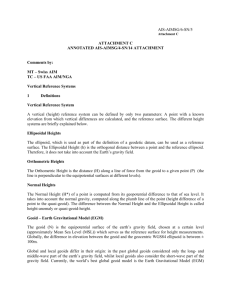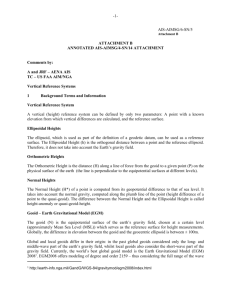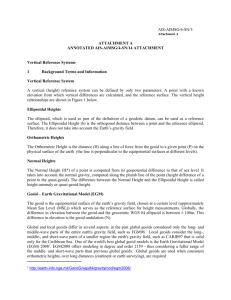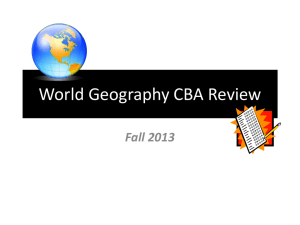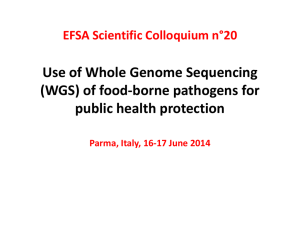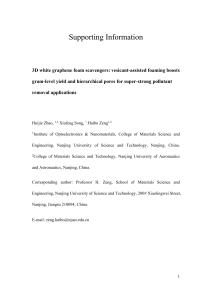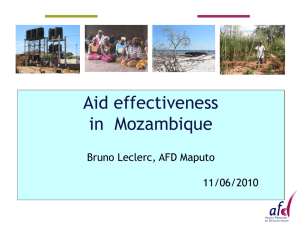VERTICAL REFERENCE SYSTEMS
advertisement
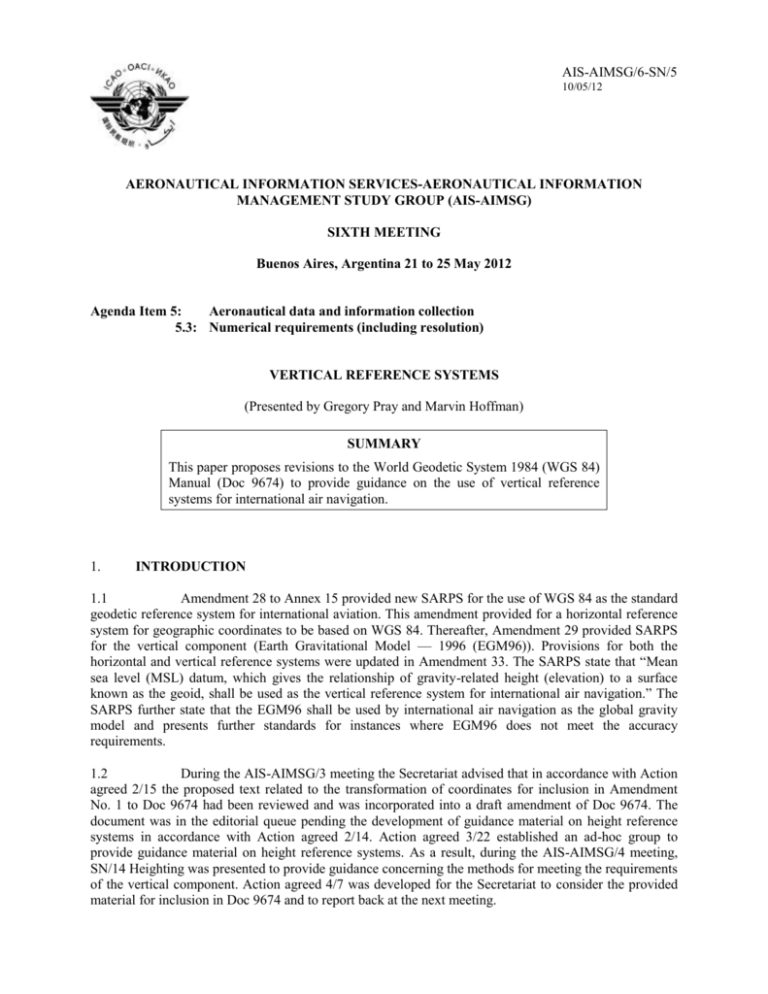
AIS-AIMSG/6-SN/5 10/05/12 AERONAUTICAL INFORMATION SERVICES-AERONAUTICAL INFORMATION MANAGEMENT STUDY GROUP (AIS-AIMSG) SIXTH MEETING Buenos Aires, Argentina 21 to 25 May 2012 Agenda Item 5: Aeronautical data and information collection 5.3: Numerical requirements (including resolution) VERTICAL REFERENCE SYSTEMS (Presented by Gregory Pray and Marvin Hoffman) SUMMARY This paper proposes revisions to the World Geodetic System 1984 (WGS 84) Manual (Doc 9674) to provide guidance on the use of vertical reference systems for international air navigation. 1. INTRODUCTION 1.1 Amendment 28 to Annex 15 provided new SARPS for the use of WGS 84 as the standard geodetic reference system for international aviation. This amendment provided for a horizontal reference system for geographic coordinates to be based on WGS 84. Thereafter, Amendment 29 provided SARPS for the vertical component (Earth Gravitational Model — 1996 (EGM96)). Provisions for both the horizontal and vertical reference systems were updated in Amendment 33. The SARPS state that “Mean sea level (MSL) datum, which gives the relationship of gravity-related height (elevation) to a surface known as the geoid, shall be used as the vertical reference system for international air navigation.” The SARPS further state that the EGM96 shall be used by international air navigation as the global gravity model and presents further standards for instances where EGM96 does not meet the accuracy requirements. 1.2 During the AIS-AIMSG/3 meeting the Secretariat advised that in accordance with Action agreed 2/15 the proposed text related to the transformation of coordinates for inclusion in Amendment No. 1 to Doc 9674 had been reviewed and was incorporated into a draft amendment of Doc 9674. The document was in the editorial queue pending the development of guidance material on height reference systems in accordance with Action agreed 2/14. Action agreed 3/22 established an ad-hoc group to provide guidance material on height reference systems. As a result, during the AIS-AIMSG/4 meeting, SN/14 Heighting was presented to provide guidance concerning the methods for meeting the requirements of the vertical component. Action agreed 4/7 was developed for the Secretariat to consider the provided material for inclusion in Doc 9674 and to report back at the next meeting. AIS-AIMSG/6-SN/5 -21.3 The methods for meeting the vertical component requirements were further discussed during the AIS-AIMSG/5 meeting. A determination was made that additional study and validation by a specialist with geodetic expertise would be necessary to revise Annex 15 SARPS concerning EGM96 and to provide guidance materials for implementation since an improved model; EGM2008 was currently available. The group noted that any revisions to Annex 15 would need to be made in Amendment 38 and, in consideration of the impact on the aviation community, be considered during the AIM/MET Divisional Meeting in 2014. 1.4 The group also recognized the work of EUROCONTROL in preparing a Data Origination Manual as part of the documentation supporting the Implementing Rule for Aeronautical Data Quality (ADQ). A number of experienced Geodesists and Surveyors together with members of one State AIS were consulted as part of the development of the manual. 1.4.1 The plan was for the document to replace the original WGS 84 manual prepared by the EUROCONTROL as part of the WGS 84 programme and which formed the basis of the original ICAO Doc 9674. The revised document takes due account of the changes in survey practice that have occurred since the original document was prepared. This document should be used as reference during the development of new SARPS and guidance material concerning EGM2008. 1.5 The group decided to take the following action: Action agreed 5/11 — Heighting That Greg and Marvin will coordinate further with eTOD working group and EUROCAE/RTCA SC217/WG44 and provide a study note at the next meeting providing an update to the material available on heighting and on the use of EGM-08. 2. DISCUSSION 2.1 The Attachment to AIS-AIMSG/4 SN/14 Heighting was used to coordinate with geodetic experts in the United States (US) and then with the EUROCONTROL TOD working group members and the EUROCAE/RTCA SC217/WG44. A copy of that Attachment is at Attachment A to this SN which incorporates changes offered by the US National Geospatial-Intelligence Agency (NGA) and includes the input by EUROCONTROL TOD working group members from Spain and Switzerland as indicated in Attachments B and C. 2.2 The original tracking changes on the Attachments B and C were provided by NGA. NGA also provided input for the final version at Attachment A. 2.2.1 An important observation is that the NGA Technical Report 8350.2, Department of Defence World Geodetic System 1984, Its Definition and Relationships with Local Geodetic Systems, Third Edition, Amendment 2, 23 June 2004 is being revised as the Fourth Edition to become available by the spring of 2013. The major changes will document the following: a) Numerical values aligned/redefined/in agreement, where practical, to the International Earth Rotation and Reference Systems Service (IERS) Conventions (2010), IERS Technical Note 36 concerning numerical standards; AIS-AIMSG/6-SN/5 -3b) The WGS 84 Coordinate Reference Frame alignment to the ITRF 2008 epoch referred to as WGS 84 (G1674); c) The Earth Gravitational Model 2008 (EGM2008); and d) World Magnetic Model loosely coupled to WGS 84. 2.2.2 It is noted that the Annex 15 horizontal and vertical reference systems SARPS should be revised after the fourth edition of the NGA technical report becomes available to provide the necessary documentation for study and support. 2.2.3 The NGA geodesists’ comments concerning the guidance in the Attachment to AISAIMSG/4 SN/14 Heighting primarily involve the following: a) Additions and changes to symbols used for terms such as “H” for “Orthometric Height” are made to fully identify all the symbols with their respective terms in a consistent manner. Additionally, under Method 3 for height determination, a correction is made to the formula for the geoid undulation relationship. b) The definition of Orthometric Heights is revised to indicate that the distance (H) is along a line of force from the geoid to a given point (P). c) As a matter of convention, the dash is not shown in the earth gravitational model acronym EGM96. The convention for EGM2008 is to show the full year. A space between the WGS acronym and year is the convention for WGS 84. d) Additional descriptive text for EGM2008 is added as well a statement of caution when using Tide-Free models such as EGM96 and EGM2008. e) Text is added to clarify that orthometric heights closely approximate MSL. f) Text concerning the use of digital terrain models (DTM) is provided to state use is possible if the sources of error in such models are fully evaluated to ensure accuracy requirements are met. 2.3 The Spanish AENA AIS provided the input in Attachment B. The input involved revisions to improve the description of the Geoid – Earth Gravitational Model (EGM) section; improved text under section 2.3 Method 2; and offered corrections to formula elements in section 2.4 Method 3. Attachment B provides the details on the comments. 2.4 The Swiss AIM provided the input in Attachment C. The input involved revisions to improve the description of the Geoid – Earth Gravitational Model (EGM) section as also pointed out by AENA AIS. Attachment C also includes comments about the Swiss recommendation to delete the reference to the caution note about the use of Tide-Free Models and the section on the European Vertical Reference System. There are other comments about the need to define orthometric heights as closely approximating MSL and the need for metadata in the collection of survey data described in section 2.2 Method 1. AIS-AIMSG/6-SN/5 -42.5 A Swiss AIM suggestion was also made to include an illustration of the relationship between ellipsoidal Height (h); orthometric height (H); and geoid undulation (N) with the correct annotations of these elements. The illustration has been added as Figure 1 to Attachment A. 2.6 A suggestion was made by the US FAA AIM and supported by the Spanish AENA AIS to provide a link to the EUROCONTROL "Specification for the Origination of Aeronautical Data" since it provides extensive documentation on the collection of vertical reference frame information in Europe. On the other hand the Swiss AIM indicates that once “the ICAO Doc 9674 has been updated, all EUROCONTROL documents should only refer to the guidance in the ICAO Doc 9674.” This issue should be discussed during the AIS-AIMSG/6 meeting. 2.7 In early April 2012 the EUROCAE/RTCA SC217/WG44 discussed the issue of making reference to the vertical reference system requirements in DO-276/ED-98 User Requirements for Terrain and Obstacle Data. The current documents refer to EGM96 and a request was submitted to change to EGM2008. In consideration of the AIS-AIMSG study of the issue and the potential change to ICAO Annex 15 as discussed in this SN a decision was made to retain EGM96 as the model to be used and to add a note that the change to EGM2008 is being considered for use by ICAO. The goal was to have everything harmonized; using the same reference system; but the unknown timing concerning the ICAO change to EGM 2008 was too great an issue to make the change at this time. 3. 3.1 RECOMMENDATION The AIS-AIMSG is invited to: a) be aware of the NGA revision of its technical report that will provide documentation concerning updates to the WGS 84 Coordinate Reference Frame and the new EGM2008 that should require revision of Annex 15 SARPS, b) discuss the content of this SN; and c) support the use of Attachment A to update ICAO Doc 9674. ———————
